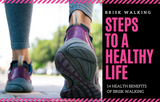
There’s increasing evidence that some simple everyday steps literally may be surprisingly powerful. What’s not to like about brisk walking? It’s free. It’s easy to do, and it’s easy on the joints. And there’s no question that walking is good for you.
Table of Contents:
What Is Brisk Walking
Brisk walking is quite vague—is it a bit faster than your normal pace? Or is it a lot faster? There are three ways to measure your speed to know that you’re doing it “briskly.”
Heart rate - the first thing you need to measure to determine if you’re walking fast enough is your heart rate. It should be between 50 and 85% of your maximum heart rate. The maximum heart rate is 220 beats per minute (bpm) minus your age in years.
• Steps per minute
Based on astudy published in the British Journal of Sports medicine, an average healthy adult who walks at least 100 steps per minute means he or she is walking fast enough to get substantial fitness benefits. An excellent way to keep track of your steps per minute is by wearing a fitness tracker.

• Talk test
If you can speak comfortably with some breathlessness, you’re walking at a moderate but brisk pace. On the other hand, if you can’t talk easily, because you’re out of breath, it could be that you’re going at a vigorous pace. If you can sing out loud while you’re walking, then that means the pace is too slow to be considered a brisk walk.

So, what is the difference between walking vs. brisk walking?
It’s simple—walking is going at a normal pace, like how you would normally walk on a Sunday to get coffee in the morning down the block. Brisk walking, on the other hand, is walking at a faster pace, but not running nor walking.
Health Benefits Of Brisk Walking And More…
Here are the health benefits of brisk walking that you should know about:
Lose Weight / Reduce Body Fat

Brisk walking has been linked to weight loss and helps reduce body fat. The amount of weight you can lose by walking varies but astudy found that participants lost an average of three pounds by walking.
Strengthen Your Heart
Brisk walking temporarily increases the heart rate and blood pressure, which leads to greater heart efficiency. The heart is a muscle with fibers that contract and pumps blood with each heartbeat. During exercise, the heart becomes more efficient and delivers more oxygen and nutrients to other organs.
• Reduce Stress and Anxiety
Brisk walking boosts the production of stress-busting endorphins. This helps reduce the stress hormones and helps relieve any signs of depression. By choosing to exercise regularly, you can help improve your mood and even increase your self-esteem.

• Strengthen Your Bones
The pull of a muscle against a bone, together with the force of gravity when you walk, will stress the bone, which response by stimulating tissue growth and renewal.
Walking helps improve bone density, particularly in the hip and femoral neck areas. Brisk walking improves bone health and osteoporosis.
Furthermore, it can help stop the loss of bone mass for people with osteoporosis. Astudy of postmenopausal women found that 30 minutes of walking every day reduced their risk of hip fractures by 40 percent.

• Extend Your Life
The fact that walking can help increase cardiovascular fitness, strengthen bones, reduce excess body fat, and boost muscle power is enough to guarantee that it can help extend your life.

• Improve Sleep
A smallstudyshowed that walking helps individuals who have difficulty falling asleep at night. It was conducted on older adults aged 55 to 65, which showed that those who walk in the morning versus the evening experienced better sleep quality at night.

• Eases Joint Pain
Walking can help protect the joints because it helps lubricate and strengthen the muscles that support the joints. If you have no arthritis or joint pain but want to prevent it, it is recommended you walk five to six miles a week.

• Improve Your Breathing
Brisk walking for at least 30 minutes is known to help improve lung capacity. It also helps strengthen the lung, which allows individuals to breathe easier. Moreover, this will help the lungs stay healthier longer.

• Slow Down Mental Decline
Research showed that 20 to 30 minutes of exercise, such as walking, before undertaking a mental task may quicken reaction time and sharpen decision making. Therefore, this slows down cognitive decline.

• Lower Alzheimer’s Risk
Astudy from the University of Virginia Health System in Charlottesville found that men between 71 and 93 years old who walked more than a quarter of a mile per day had half the incidence of Alzheimer’s disease and dementia compared to those who walk less.

• Boost Your Energy
A walk will help increase the oxygen flow through the body, which will increase the level of cortisol along with other hormones that can help elevate energy levels.

• Boost Immune Function
Brisk walking can also help boost your immune function, which will protect you from a cold, the flu, and other immune-related diseases. Physical exercise, such as walking, helps increase the number of white blood cells circulating in the blood. These cells fight infection and other conditions as part of the body’s immune system.
• Free For Life
Brisk walking doesn’t require any equipment at all and you can do it anywhere you want. You don’t need a gym membership or a personal trainer. That means you don’t have to pay for anything at all.

• Brisk Walking Is A Social Activity That Can Be Shared With Others
If you haven’t been out with people, you can take advantage of the time you allot for walking to do it with your friends, your spouse, or even your dog. With this, you get to maintain a healthy social life while you boost your overall health.

How To Get Started
Choose a walking route near your home. Or look for a scenic place to walk in your area, such as a trail or on the beach.
Tips For Staying Safe While Brisk Walking
- Get the most benefits by walking at least 30 minutes as briskly as you can. Moderate activities, such as walking pose a little health risk, but if you have a medical condition check with your doctor first.
- It is essential to stretch before brisk walking to help avoid injuries. You can start by stretching your leg muscles, specifically your calves, and front and back thighs. Hold each stretch for at least 20 seconds.
- A good warm-up is to walk slowly. You can start your brisk walk by walking at a leisurely pace to give your muscles time to warm up before you pick up the pace.
- Make sure you are wearing the proper gear. Keep it light, especially during the summer. As much as possible, avoid layering up because this can increase sweating, which will build up body temperature that can make you feel uncomfortable.
- Make sure you have the proper pair of walking shoes. Your shoes should be comfortable and provide you with adequate heel and arch support.
- Take light and easy steps. When walking, ensure that your heel touches down before your toes.
- If possible, walk on grass or sand instead of concrete.
- Make sure you wear reflective or bright-colored clothing, especially if you will be walking on the side of a busy road and at night. This will help keep you safe.
- Wear gloves to keep your hands warm. Our reflective gloves offer safety and protection, while they can let you easily use your mobile phones while wearing them as they are touchscreen compatible.
- When it comes to sun protection, always have a hat on if you are walking during the day. This will help avoid sunburn, wrinkles, and most importantly skin cancer. Here at GearTop, we have a wide range of sun hats that can offer you maximum protection.
- Make sure that you always stay hydrated. Carry enough water with you while brisk walking to avoid heat exhaustion, especially during the summer.
Conclusion
How many of us can commit to taking at least a 30-minute brisk walk on a regular basis? It can feel overwhelming at times, but it doesn't have to be complicated.
In fact, it's possible to take a simple, realistic approach towards living a healthy lifestyle that actually feels achievable each day. A step at a time, enjoying the morning breeze while staying protected with our Sun Hat collection.
Check out our gloves as well, such as our reflective running gloves reflective running gloves. If you are not needing reflective features, we offer performance gloves as well.
Either way, both these gloves will provide you with that additional grip, which means you can also take them when hiking to minimize blisters from hiking poles, and bring them out for other outdoor activities, such as brisk walking, running, and more!





Leave a comment (all fields required)